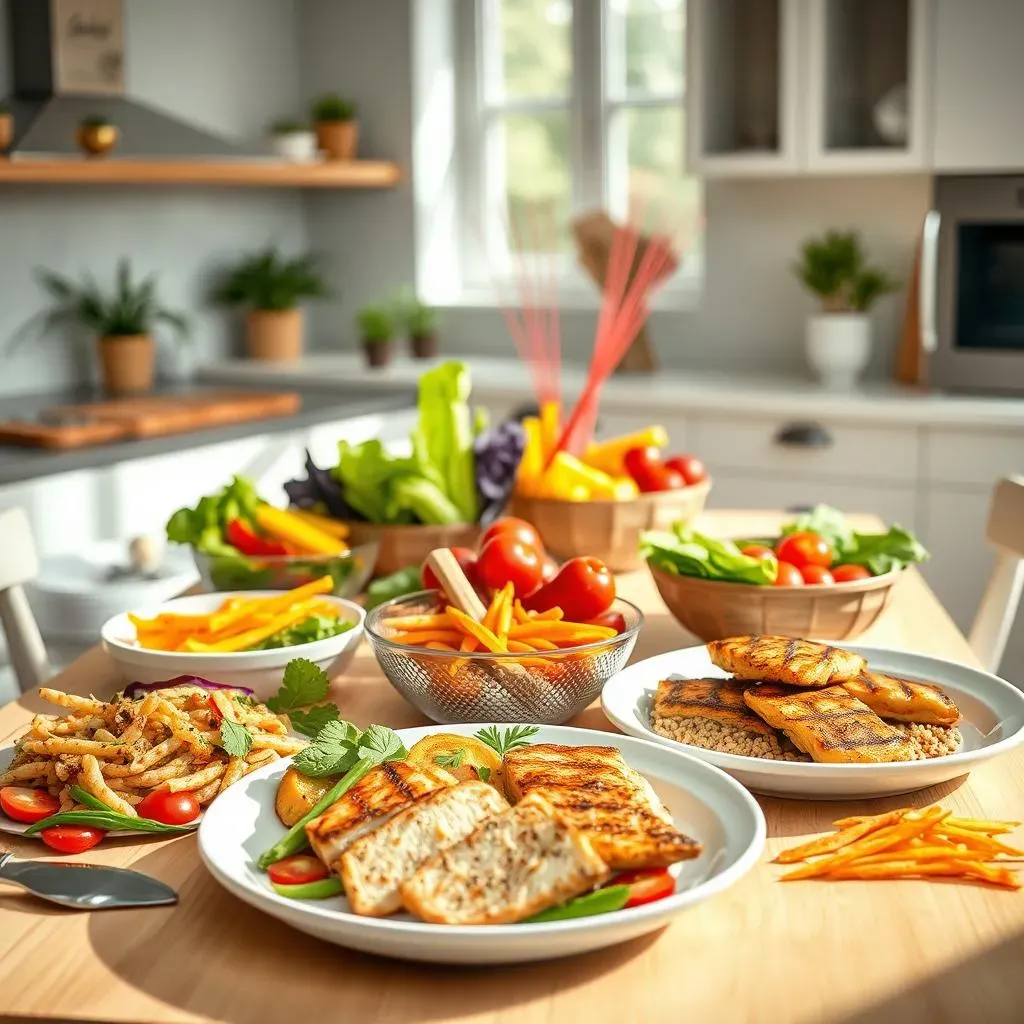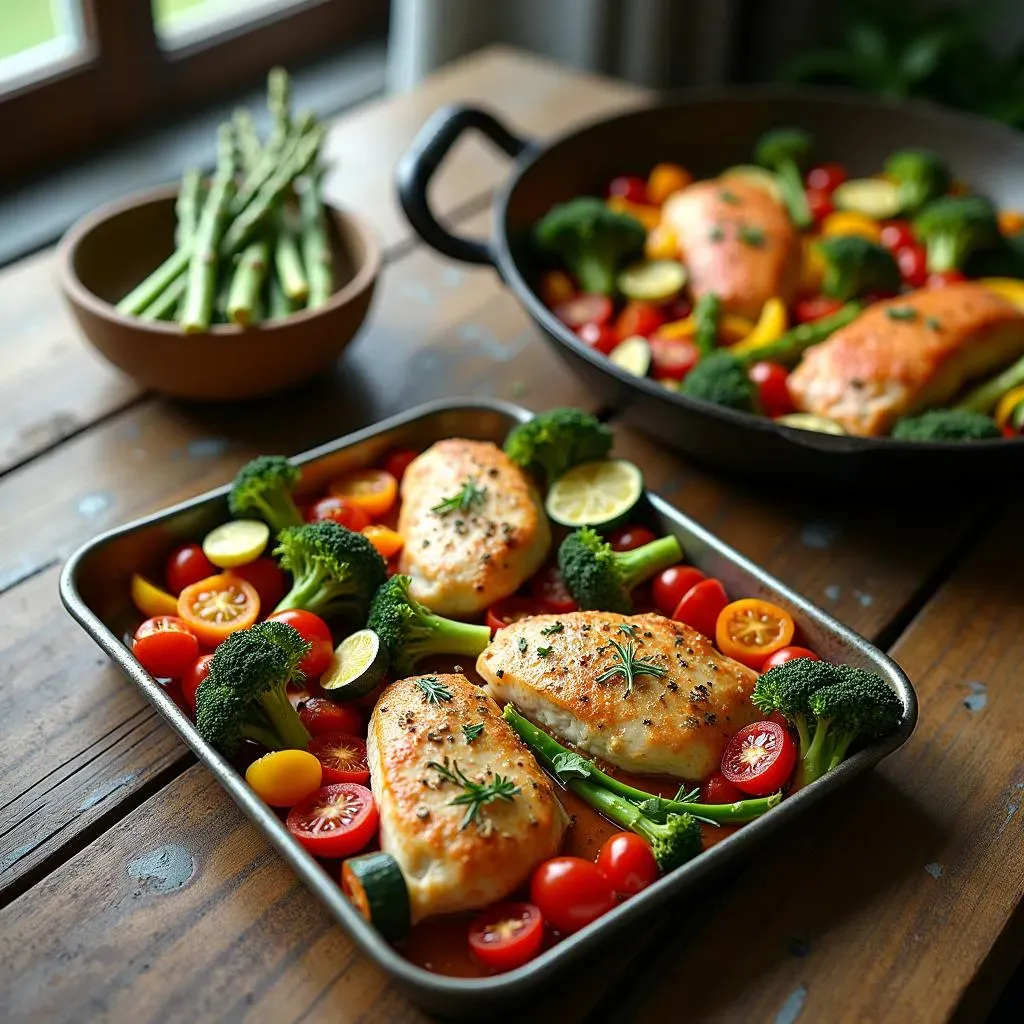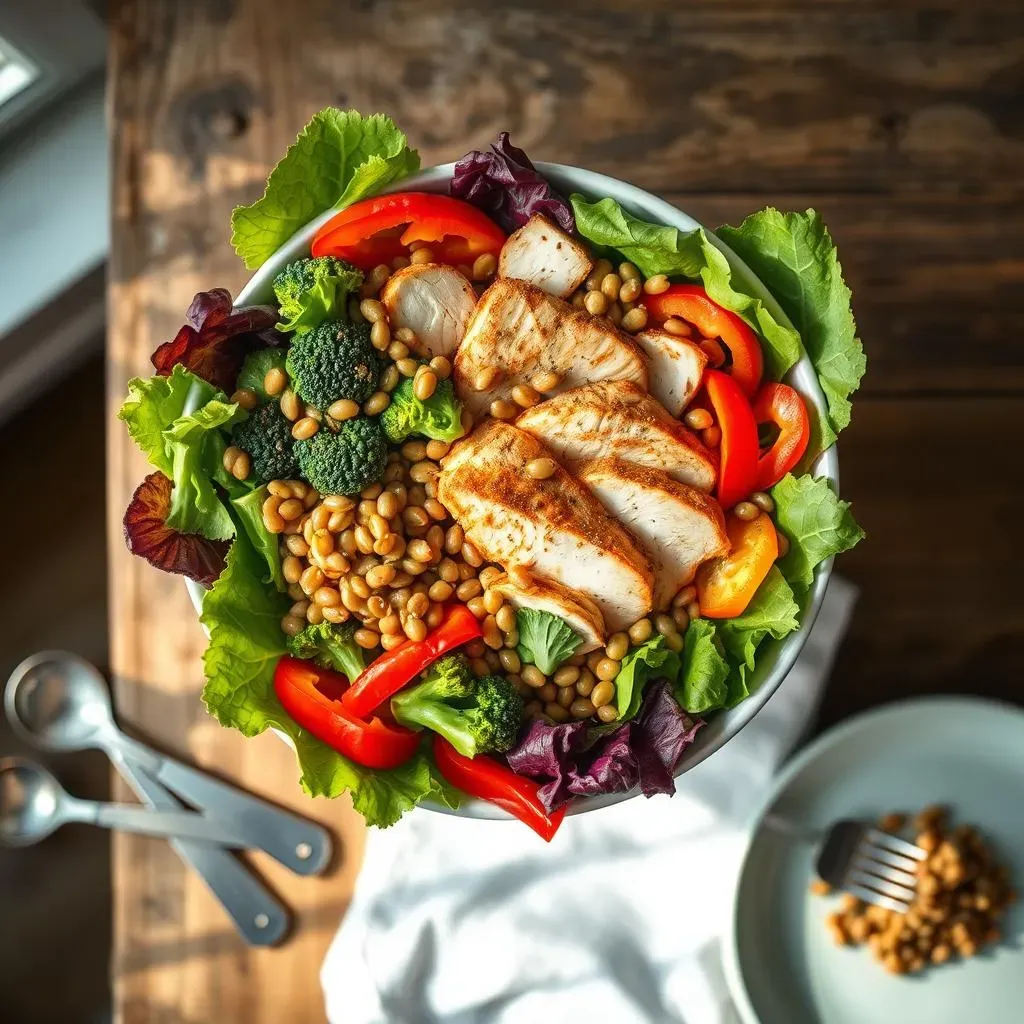Table of Contents
Struggling to find satisfying dinners that won't derail your health goals? You're not alone. Many people find it challenging to balance taste, convenience, and calorie count when it comes to evening meals. But what if I told you that you could enjoy delicious, filling dinners without exceeding your calorie limits? This guide is your passport to a world of healthy dinner low calorie options that are both easy to prepare and incredibly satisfying.
Why Choose Healthy Low Calorie Dinners?

Why Choose Healthy Low Calorie Dinners?
Weight Management and Calorie Control
Let's face it, many of us are trying to manage our weight, and dinner can be a real sticking point. It's easy to overeat at the end of the day, especially after a long and stressful one. Choosing healthy low calorie dinners is a proactive way to control your calorie intake without feeling deprived. It’s not about restriction; it's about making smarter choices that nourish your body while supporting your weight goals. By focusing on nutrient-dense, lower-calorie options, you can enjoy satisfying meals that keep you on track.
Think about it: a simple swap from a heavy, creamy pasta dish to a grilled chicken salad loaded with veggies can save you hundreds of calories. These small changes add up over time, leading to sustainable weight management and improved overall health. Plus, when you eat lighter at dinner, you're less likely to wake up feeling bloated and sluggish.
Boosting Energy Levels and Improving Sleep
Ever notice how heavy, high-calorie meals can leave you feeling sluggish and tired? That's because your body is working overtime to digest all that food. Healthy low calorie dinners, on the other hand, are often easier to digest, allowing your body to focus on repairing and rejuvenating itself overnight. This can lead to increased energy levels during the day and improved sleep quality.
When you choose lighter, healthier options for dinner, you're also more likely to incorporate more fruits, vegetables, and lean proteins into your diet. These foods are packed with essential vitamins and minerals that support optimal bodily function. A well-nourished body is an energized body, ready to tackle whatever the day throws your way. Plus, better sleep means better mood, improved focus, and enhanced overall well-being.
Benefit | Explanation |
|---|---|
Weight Management | Control calorie intake without feeling deprived. |
Increased Energy | Easier digestion, more nutrients. |
Improved Sleep | Body focuses on repair, not digestion. |
Long-Term Health Benefits
Choosing healthy low calorie dinners isn't just about short-term weight loss; it's an investment in your long-term health. A diet rich in fruits, vegetables, lean proteins, and whole grains can significantly reduce your risk of developing chronic diseases such as heart disease, type 2 diabetes, and certain types of cancer. By making healthy choices at dinner, you're setting yourself up for a longer, healthier life.
Moreover, adopting a healthy eating pattern can have a positive impact on your mental health. Studies have shown that a balanced diet can improve mood, reduce stress, and even alleviate symptoms of depression and anxiety. So, the next time you're planning your dinner, remember that you're not just nourishing your body; you're nourishing your mind as well. It’s a win-win situation!
Delicious and Easy Healthy Dinner Low Calorie Recipes

Delicious and Easy Healthy Dinner Low Calorie Recipes
Quick & Easy Sheet Pan Lemon Herb Chicken and Veggies
Sheet pan dinners are a lifesaver on busy weeknights! This recipe is incredibly simple: toss chicken breast and your favorite veggies (broccoli, bell peppers, zucchini, and cherry tomatoes work great) with olive oil, lemon juice, and herbs like rosemary, thyme, and garlic. Spread everything on a sheet pan and bake until the chicken is cooked through and the veggies are tender. It's a complete meal with minimal cleanup, packed with protein and fiber, and easily customizable to your liking. Plus, the lemon and herbs add a burst of flavor that makes it feel way more indulgent than it is!
I'm telling you, this is a game-changer. I often prep the veggies ahead of time on Sunday, so when it's dinner time during the week, it takes me only 5 minutes to get it ready and into the oven. Then, I can relax or work on other things while dinner cooks itself. What's better than that?
One-Pan Salmon with Asparagus
Another fantastic one-pan wonder! Salmon is a nutritional powerhouse, loaded with omega-3 fatty acids, and asparagus is a delicious, low-calorie veggie. Simply place salmon fillets and asparagus spears on a baking sheet, drizzle with olive oil, season with salt, pepper, and a squeeze of lemon juice, and bake until the salmon is cooked through and the asparagus is tender-crisp. This meal is not only healthy and low in calories, but it's also elegant enough for a dinner party. Seriously, who says healthy can't be fancy?
Want to elevate this dish? Sprinkle some toasted almonds or pine nuts over the salmon and asparagus before serving for added texture and flavor. You can also experiment with different seasonings, like dill, paprika, or garlic powder. The possibilities are endless!
Recipe | Calories (approx.) | Key Ingredients |
|---|---|---|
Sheet Pan Lemon Herb Chicken and Veggies | 350 | Chicken breast, broccoli, bell peppers, lemon, herbs |
One-Pan Salmon with Asparagus | 400 | Salmon, asparagus, olive oil, lemon |
Tips for Creating Your Own Healthy Low Calorie Meals

Tips for Creating Your Own Healthy Low Calorie Meals
Focus on Volume with Veggies
Seriously, load up on those veggies! Non-starchy vegetables like leafy greens, broccoli, cauliflower, bell peppers, and zucchini are your best friends when it comes to creating low-calorie, filling meals. They're packed with fiber, which helps you feel full and satisfied, and they're incredibly low in calories. Don't be shy about adding them to your dishes – the more, the merrier! Think about bulking up your pasta sauces with chopped veggies, adding a side salad to every meal, or even snacking on raw veggies with hummus or salsa.
I always keep a variety of pre-cut veggies in my fridge for easy snacking and meal prep. It makes it so much easier to add a handful of spinach to my morning smoothie or throw some chopped bell peppers into my stir-fries. Trust me, it's a game-changer!
Embrace Lean Protein Sources
Protein is essential for building and repairing tissues, and it also helps you feel full and satisfied. Choosing lean protein sources like chicken breast, turkey, fish, beans, lentils, and tofu is a great way to keep your calorie count down while ensuring you're getting enough protein. These options are lower in fat and calories than fattier cuts of meat, making them ideal for healthy low calorie dinners. Experiment with different cooking methods like grilling, baking, or poaching to keep things interesting.
I love using ground turkey or chicken in my tacos and chili instead of ground beef. It's a simple swap that saves a ton of calories without sacrificing flavor. And don't forget about plant-based protein sources like beans and lentils – they're packed with fiber and nutrients, and they're incredibly versatile.
Tip | Description |
|---|---|
Load Up on Veggies | Add lots of non-starchy vegetables to your meals for volume and fiber. |
Choose Lean Protein | Opt for chicken breast, fish, beans, lentils, and tofu. |
Control Portion Sizes | Be mindful of how much you're eating to manage calorie intake. |
Control Portion Sizes Mindfully
Even healthy foods can lead to weight gain if you eat too much of them. Being mindful of your portion sizes is crucial for creating healthy low calorie meals. Use smaller plates and bowls to help you visually control your portions, and pay attention to your hunger cues. Eat slowly and savor each bite, and stop eating when you feel satisfied, not stuffed. It takes about 20 minutes for your brain to register that you're full, so give yourself time to digest before reaching for seconds.
I find it helpful to pre-portion my meals into containers for the week. This way, I don't have to think about it when I'm hungry and tired after a long day. It's a simple but effective way to stay on track with my calorie goals.
Maintaining a Healthy Lifestyle with Low Calorie Dinners

Maintaining a Healthy Lifestyle with Low Calorie Dinners
Making Sustainable Changes
so you've got some delicious low-calorie dinner recipes under your belt, that's awesome! But the real trick is making these changes stick for the long haul. Crash diets and quick fixes are never the answer. Instead, focus on making small, sustainable changes to your eating habits that you can maintain over time. This might mean gradually reducing your portion sizes, swapping out unhealthy ingredients for healthier ones, or simply cooking at home more often. Remember, it's a marathon, not a sprint!
I always tell people to start with one or two small changes each week. Maybe this week you focus on adding a side salad to every dinner. Next week, you swap out sugary drinks for water. Over time, these small changes will add up to big results. And don't beat yourself up if you slip up – it happens to everyone! Just get back on track with your next meal.
Planning and Preparation are Key
Life gets busy, and it's easy to fall off track when you're short on time and energy. That's why planning and preparation are so important. Take some time each week to plan out your meals, make a grocery list, and prep ingredients in advance. This will make it much easier to stick to your healthy eating goals, even when you're feeling stressed or overwhelmed. Think about batch cooking on the weekends, so you have healthy meals ready to go during the week. Or try meal prepping individual ingredients like chopped veggies or cooked grains that you can easily add to your dinners.
I personally love using meal planning apps to help me stay organized. They make it so easy to create a grocery list, track my calories, and find new recipes. But even a simple handwritten meal plan can make a big difference. The key is to find a system that works for you and stick with it.
Strategy | Description |
|---|---|
Sustainable Changes | Make small, gradual adjustments to your eating habits. |
Meal Planning | Plan your meals in advance and prep ingredients. |
Mindful Eating | Pay attention to your hunger cues and savor each bite. |
Embracing Mindful Eating Practices
Mindful eating is all about paying attention to your food and your body. It's about slowing down, savoring each bite, and listening to your hunger cues. Instead of mindlessly shoveling food into your mouth while watching TV, try to focus on the taste, texture, and smell of your food. Notice how your body feels as you eat, and stop when you feel satisfied, not stuffed. Mindful eating can help you break free from emotional eating and develop a healthier relationship with food.
Try practicing mindful eating at least once a day. Start by taking a few deep breaths before you begin eating. Then, put your fork down between bites and focus on chewing your food thoroughly. Notice how your body feels as you eat, and stop when you feel satisfied. It may take some practice, but over time, mindful eating can become a natural part of your routine.
Conclusion: Savoring the Journey to Healthy Eating
Embarking on a journey towards healthy eating with a focus on low-calorie dinners doesn't have to feel like a sacrifice. By understanding the benefits, experimenting with delicious recipes, and incorporating simple tips into your daily routine, you can create a sustainable and enjoyable path to better health. Remember, it's about making mindful choices that nourish your body and satisfy your taste buds. So, keep exploring, keep experimenting, and keep savoring the journey to a healthier, happier you, one delicious and healthy dinner low calorie meal at a time.